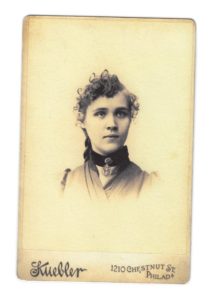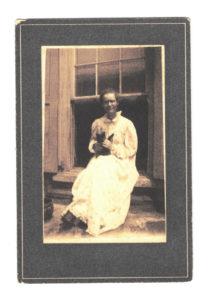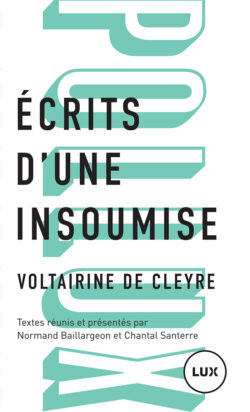Sous-total: $
Overlooked No More: Voltairine de Cleyre, America’s ‘Greatest Woman Anarchist’
At a time of rampant income inequality, stifling social roles for women and church-mandated morality, de Cleyre rebelled against the accepted order.

At 24, Voltairine de Cleyre appeared before Philadelphia’s Unity Congregation to deliver a lecture, provocatively titled “Sex Slavery.”
She appealed to the assembled crowd: “Let woman ask herself, ‘Why am I the slave of man? Why is my brain said not to be the equal of his brain? Why is my work not paid equally with his?’ ”
The year was 1890.
It was a time of rampant income inequality, stifling social roles for women and church-mandated morality, and many in the growing American middle class were ready for change.
De Cleyre rebelled against the accepted order and delivered searing critiques of capitalism and state power, whose abuses she saw manifested in many facets of life, from labor to prisons to marriage (proposals for which she twice rejected).
She adopted anarchism as a political philosophy and became one of the movement’s most prominent and determined supporters, establishing a reputation as a transfixing speaker and earning the admiration of her fellow freethinkers.
Her contemporary, Emma Goldman, called her “the poet-rebel, the liberty-loving artist, the greatest woman anarchist of America.”
More significantly, for historians of the period, “she pointed to gender oppression, the power of the state and capitalism as being interconnected,” Sandra Jeppesen, an associate professor of interdisciplinary studies at Lakehead University in Orillia, Ontario, said by email.
Not only was she concerned about women’s issues from a woman’s perspective, but “because she was poor, she was also involved in working class struggles and Jewish immigrant support work,” Jeppesen said.
De Cleyre’s views, which she propagated prolifically in poems and essays, were grounded in personal experience.
De Cleyre, who was named after the Enlightenment philosopher Voltaire, was born on Nov. 17, 1866, in Leslie, Mich. Her family struggled with poverty. Her father, Hector de Cleyre, was an itinerant tailor from France who won his American citizenship fighting in the Civil War. Her mother, Harriet Elizabeth Billings, came from an abolitionist family in upstate New York.
The youngest of three sisters, de Cleyre created a desk by placing a board on the limb of a maple tree so that she would have a private place to write. She drafted her first poem at age 6.
She spent three years in a Catholic convent school, where she developed a deep animus toward dogma and forced obedience. But the experience also sharpened her rhetorical skills.
De Cleyre was just 19 when she began writing and lecturing on Free Thought, a questioning of traditional religious and social beliefs. She traveled between Ohio and Boston and settled in Philadelphia, where in 1892 she founded a social group called the Ladies’ Liberal League. The group’s purpose was not “to smile men into ticket-buying and shame them into candy purchase,” she said, but to host discussions on sex, prohibition, socialism, anarchism and revolution. For income, she gave private lessons in English, penmanship and music at her home.

And then Chicago’s Haymarket affair became her conversion moment.
On May 3, 1886, Chicago police officers fired into a crowd of strikers at the McCormick Reaper Works, killing and wounding several men. In response, a group of anarchists met near Haymarket Square the following evening. When the police tried to disperse them, someone threw a bomb and seven officers were killed. Eight anarchists were arrested, six of whom had not been present when the incident occurred. Four were hanged, a fifth committed suicide in jail and the three others were pardoned years later.
The men instantly became martyrs to the anarchist movement, and de Cleyre channeled her outrage at the “infamy” of the trial and executions into a vigorous endorsement of anarchism, speaking annually at Haymarket memorials and returning to the subject again and again in her writings.
“The question ‘Why I am an Anarchist,’ ” she wrote in 1897, “I could very summarily answer with, ‘because I cannot help it.’ ”
Beyond her activism, De Cleyre had many romantic entanglements but none were fully satisfying, , according to a biographer, Paul Avrich. The labor activist Dyer D. Lum, who was 27 years her senior, was the first man to treat her as an intellectual equal, but he left her heartbroken when he took his own life. She bore her only child, Harry, with James B. Elliot, a carpenter who was a believer in the writings of the freethinker Thomas Paine. Yet eventually she pushed both away, reluctant to be a mother or wife.
The assassination of President William McKinley by the anarchist Leon Czolgosz in 1901 unleashed a wave of anti-anarchist sentiment. When Senator Joseph R. Hawley of Connecticut offered $1,000 to anyone who shot an anarchist, de Cleyre responded with a letter telling him to save his money; he could kill her.
“I will stand straight before you at any distance you wish me to, and you may shoot, in the presence of witnesses,” she wrote. “Does not your American commercial instinct seize upon this as a bargain?”
The following year de Cleyre had her own brush with an assassin. A former student of hers who had become romantically obsessed with her shot her in a jealous rage. She survived, and then worked for his release on her recovery.
“It would be an outrage against civilization if he were sent to jail for an act which was the product of a diseased brain,” she wrote.
But behind her fiery public persona lurked depression and disappointment, along with chronic physical pain and recurring illness. “I never feel at home anywhere,” de Cleyre was quoted by Goldman as saying. “I feel like a lost or wandering creature that has no place, and cannot find anything to be at home with.”
From an early age she suffered bouts of catarrh, a sinus-related problem, that sometimes left her weak and bedridden, and she often complained of a pounding in her ears. At one point, she attempted suicide with a morphine overdose.
By 1910, her health in decline, de Cleyre found herself disillusioned with her life’s work, writing to a friend: “I can see no use in doing anything. Everything turns bitter in my mouth and ashes in my hands.” She moved to Chicago and was briefly reinvigorated by news of the Mexican revolution. She took Spanish lessons and prepared for a trip to Los Angeles, to be closer to the conflict, but fell ill for the final time.
De Cleyre died on April 17, 1912. She was 45. The cause was a cranial infection that had developed out of a perforated eardrum. She is buried in Forest Home Cemetery in Chicago, near the Haymarket Martyrs’ Monument.
Despite her suffering, she wrote that she would not have traded her poor health for wellness if it mean giving up her beliefs in the anarchist cause.
As she put it in a 1903 essay titled “The Making of an Anarchist”: “Let me keep the intensity of my soul, with all the limitations of my conditions, rather than become the spineless and ideal-less creation of material needs.”
Michael B. Dougherty, The New York Times, 26 septembre 2018
Lisez l’original ici.
 Mon compte
Mon compte





